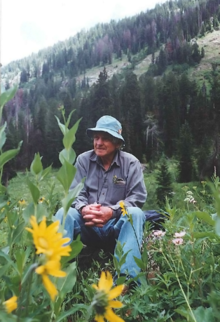Garniss Curtis
Garniss Hearfield Curtis (born May 27, 1919 in San Rafael , California , † December 19, 2012 in Orinda , California) was an American geologist and pioneer in the field of the use of isotope geochemistry for the determination of the age of fossils .
Life
Curtis was baptized as Chester Alphonse Kemp . After his parents divorced, his mother changed the name to Garniss Hearfield Kemp . He later took the surname of his stepfather, so that from then on his name was Garniss Hearfield Curtis.
In 1942 he graduated from the University of California, Berkeley , the Bachelor -degree in field Mining Engineering (Mining Engineering). He then worked in Arizona as a mining engineer at Christmas Copper Corporation until 1945 and as a geologist at Shell Oil Company the following year. He returned to the University of California, Berkeley, where he received his doctorate degree ( Ph.D. ) in geology in 1951 and was employed as an assistant professor at Berkeley that same year . Volcanological field studies at Mount Katmai in Alaska from 1953 onwards turned his attention to the dating of volcanic ashes .
In 1958 Curtis was promoted to associate professor at Berkeley and finally appointed professor of geology and geophysics in 1964, a position he held until his retirement in 1989. From 1988 to 1994 he also worked - temporarily as director of geochronology - at the Institute of Human Origins in Berkeley, and in 1994 he founded the Berkeley Geochronology Center.
Garniss Curtis was married to his wife Dorette Davis Curtis, who died in 1987, for 45 years; the couple had three children.
research
In the early 1960s, Curtis developed in collaboration a. a. with John Reynolds' method for radiometric dating of rock samples, especially volcanic ash, using the potassium-argon method . At the same time explored Donald E. Savage , the evolution - the speed of the shape change - the fossil mammal - fauna of North America . The result of the convergence of these different research approaches was that the precise dating of volcanic deposits made it possible to date the fossils between two such layers. It was Curtis' special achievement to apply the method developed by Reynolds to relatively young, a few million years old deposits and thus to make them usable for human tribal history .
While Curtis initially primarily correlated North American ash layers with deposits in Europe , he nevertheless also used the potassium-argon method for dating African fossils. In 1961, for example, his - initially controversial, but ultimately correct - dating of the skull OH5 (“Zinj”) of a Paranthropus boisei , who was interpreted as the ancestor of anatomically modern humans ( Homo sapiens ), caused a worldwide stir . Its age of at least 1.75 million years meant that the human lineage had suddenly been extended more than a million years into the past. From 1966 his student Frank Brown also devoted himself to the volcanic ashes in East Africa and, over the next almost 50 years, worked out a dated chronology of more than 300 ash layers for this region, which is considered to be the cradle of mankind .
His dating of Asian sites of Homo erectus also caused a stir in the 1990s , suggesting that Homo erectus and Homo sapiens lived side by side for a time, for example in Java .
Honors
Garniss Curtis was an elected member ( Fellow ) of the American Association for the Advancement of Science from 1998 and President of the Pacific Division of this scientific society for several years.
Fonts (selection)
- The geology of the Topaz Lake Quadrangle and the eastern half of Ebbetts Pass Quadrangle. University of California, Berkeley 1951, dissertation.
- with Andrew Hill, Steven Ward, Alan Deino and Robert Drake: Earliest Homo. In: Nature . Volume 355, 1992, pp. 719-722, doi: 10.1038 / 355719a0
- with Carl C. Swisher III et al .: Age of the earliest known hominids in Java, Indonesia. In: Science . Volume 263, No. 5150, 1994, pp. 1118-1121, doi: 10.1126 / science.8108729
- with Carl C. Swisher III and Roger Lewin: Java Man: How Two Geologists Changed Our Understanding of Human Evolution. University of Chicago Press, 2001, ISBN 978-022678734-3 .
literature
- William Henry Gilbert: Garniss Curtis (1919–2012): Dating Our Past. In: PLoS Biology. Volume 11, No. 9: e1001650, doi: 10.1371 / journal.pbio.1001650 (full text freely accessible)
Web links
- Connecting the Links: Louis Leakey, Olduvai Gorge, and Garniss Curtis. On: ncse.com (National Center for Science Education) September 26, 2013
Individual evidence
- ↑ a b Garniss Curtis, pioneer of precision fossil dating, has died at 93. On: news.berkeley.edu of February 26, 2013
- ↑ Curriculum vitae on garnisscurtis.net ( memento from January 26, 2016 in the Internet Archive ), viewed on December 17, 2017
- ↑ How old is a person? Bones found in the Oldoway Gorge shocked science. On: zeit.de of October 6, 1961
- ↑ CC Swisher III, WJ Rink, SC Antón, HP Schwarcz, GH Curtis and A. Suprijo Widiasmoro: Latest Homo erectus of Java: Potential Contemporaneity with Homo sapiens in Southeast Asia. In: Science . Volume 274, No. 5294, 1996, pp. 1870-874, doi: 10.1126 / science.274.5294.1870
| personal data | |
|---|---|
| SURNAME | Curtis, Garniss |
| ALTERNATIVE NAMES | Curtis, Garniss Hearfield |
| BRIEF DESCRIPTION | American geologist |
| DATE OF BIRTH | May 27, 1919 |
| PLACE OF BIRTH | San Rafael , California |
| DATE OF DEATH | December 19, 2012 |
| Place of death | Orinda , California |
